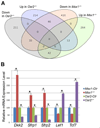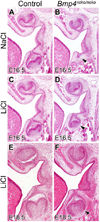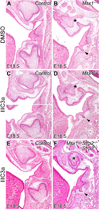Bmp4-Msx1 signaling and Osr2 control tooth organogenesis through antagonistic regulation of secreted Wnt antagonists
- PMID: 27713059
- PMCID: PMC5416936
- DOI: 10.1016/j.ydbio.2016.10.001
Bmp4-Msx1 signaling and Osr2 control tooth organogenesis through antagonistic regulation of secreted Wnt antagonists
Abstract
Mutations in MSX1 cause craniofacial developmental defects, including tooth agenesis, in humans and mice. Previous studies suggest that Msx1 activates Bmp4 expression in the developing tooth mesenchyme to drive early tooth organogenesis. Whereas Msx1-/- mice exhibit developmental arrest of all tooth germs at the bud stage, mice with neural crest-specific inactivation of Bmp4 (Bmp4ncko/ncko), which lack Bmp4 expression in the developing tooth mesenchyme, showed developmental arrest of only mandibular molars. We recently demonstrated that deletion of Osr2, which encodes a zinc finger transcription factor expressed in a lingual-to-buccal gradient in the developing tooth bud mesenchyme, rescued molar tooth morphogenesis in both Msx1-/- and Bmp4ncko/ncko mice. In this study, through RNA-seq analyses of the developing tooth mesenchyme in mutant and wildtype embryos, we found that Msx1 and Osr2 have opposite effects on expression of several secreted Wnt antagonists in the tooth bud mesenchyme. Remarkably, both Dkk2 and Sfrp2 exhibit Osr2-dependent preferential expression on the lingual side of the tooth bud mesenchyme and expression of both genes was up-regulated and expanded into the tooth bud mesenchyme in Msx1-/- and Bmp4ncko/ncko mutant embryos. We show that pharmacological activation of canonical Wnt signaling by either lithium chloride (LiCl) treatment or by inhibition of DKKs in utero was sufficient to rescue mandibular molar tooth morphogenesis in Bmp4ncko/ncko mice. Furthermore, whereas inhibition of DKKs or inactivation of Sfrp2 alone was insufficient to rescue tooth morphogenesis in Msx1-/- mice, pharmacological inhibition of DKKs in combination with genetic inactivation of Sfrp2 and Sfrp3 rescued maxillary molar morphogenesis in Msx1-/- mice. Together, these data reveal a novel mechanism that the Bmp4-Msx1 pathway and Osr2 control tooth organogenesis through antagonistic regulation of expression of secreted Wnt antagonists.
Keywords: Bmp4; Dkk2; Mouse; Msx1; Organogenesis; Osr2; Sfrp2; Tooth development; Wnt signaling.
Copyright © 2016 Elsevier Inc. All rights reserved.
Figures






Similar articles
-
Activin and Bmp4 Signaling Converge on Wnt Activation during Odontogenesis.J Dent Res. 2017 Sep;96(10):1145-1152. doi: 10.1177/0022034517713710. Epub 2017 Jun 12. J Dent Res. 2017. PMID: 28605600 Free PMC article.
-
Roles of Bmp4 during tooth morphogenesis and sequential tooth formation.Development. 2013 Jan 15;140(2):423-32. doi: 10.1242/dev.081927. Development. 2013. PMID: 23250216 Free PMC article.
-
Deletion of Osr2 Partially Rescues Tooth Development in Runx2 Mutant Mice.J Dent Res. 2015 Aug;94(8):1113-9. doi: 10.1177/0022034515583673. Epub 2015 Apr 27. J Dent Res. 2015. PMID: 25916343 Free PMC article.
-
Genes affecting tooth morphogenesis.Orthod Craniofac Res. 2007 Nov;10(4):237-44. doi: 10.1111/j.1601-6343.2007.00407.x. Orthod Craniofac Res. 2007. PMID: 17973693 Review.
-
Genes affecting tooth morphogenesis.Orthod Craniofac Res. 2007 Aug;10(3):105-13. doi: 10.1111/j.1601-6343.2007.00395.x. Orthod Craniofac Res. 2007. Corrected and republished in: Orthod Craniofac Res. 2007 Nov;10(4):237-44. doi: 10.1111/j.1601-6343.2007.00407.x. PMID: 17651126 Corrected and republished. Review.
Cited by
-
Transcriptome profile of highly osteoblastic/cementoblastic periodontal ligament cell clones.J Appl Oral Sci. 2020 Oct 23;28:e20200242. doi: 10.1590/1678-7757-2020-0242. eCollection 2020. J Appl Oral Sci. 2020. PMID: 33111882 Free PMC article.
-
The Secretome of the Inductive Tooth Germ Exhibits Signals Required for Tooth Development.Bioengineering (Basel). 2025 Jan 21;12(2):96. doi: 10.3390/bioengineering12020096. Bioengineering (Basel). 2025. PMID: 40001617 Free PMC article.
-
Gene regulatory network from cranial neural crest cells to osteoblast differentiation and calvarial bone development.Cell Mol Life Sci. 2022 Feb 27;79(3):158. doi: 10.1007/s00018-022-04208-2. Cell Mol Life Sci. 2022. PMID: 35220463 Free PMC article. Review.
-
Tooth Regeneration: Insights from Tooth Development and Spatial-Temporal Control of Bioactive Drug Release.Stem Cell Rev Rep. 2020 Feb;16(1):41-55. doi: 10.1007/s12015-019-09940-0. Stem Cell Rev Rep. 2020. PMID: 31834583 Free PMC article. Review.
-
Modulating Wnt Signaling Rescues Palate Morphogenesis in Pax9 Mutant Mice.J Dent Res. 2017 Oct;96(11):1273-1281. doi: 10.1177/0022034517719865. Epub 2017 Jul 10. J Dent Res. 2017. PMID: 28692808 Free PMC article.
References
-
- Andl T, Reddy ST, Gaddapara T, Millar SE. WNT signals are required for the initiation of hair follicle development. Dev. Cell. 2002;2:643–653. - PubMed
-
- Bei M, Kratochwil K, Maas RL. BMP4 rescues a non-cell-autonomous function of Msx1 in tooth development. Development. 2000;127:4711–4718. - PubMed
-
- Chai Y, Jiang X, Ito Y, Bringas P, Jr, Han J, Rowitch DH, Soriano P, McMahon AP, Sucov HM. Fate of the mammalian cranial neural crest during tooth and mandibular morphogenesis. Development. 2000;127:1671–1679. - PubMed
MeSH terms
Substances
Grants and funding
LinkOut - more resources
Full Text Sources
Other Literature Sources
Molecular Biology Databases

